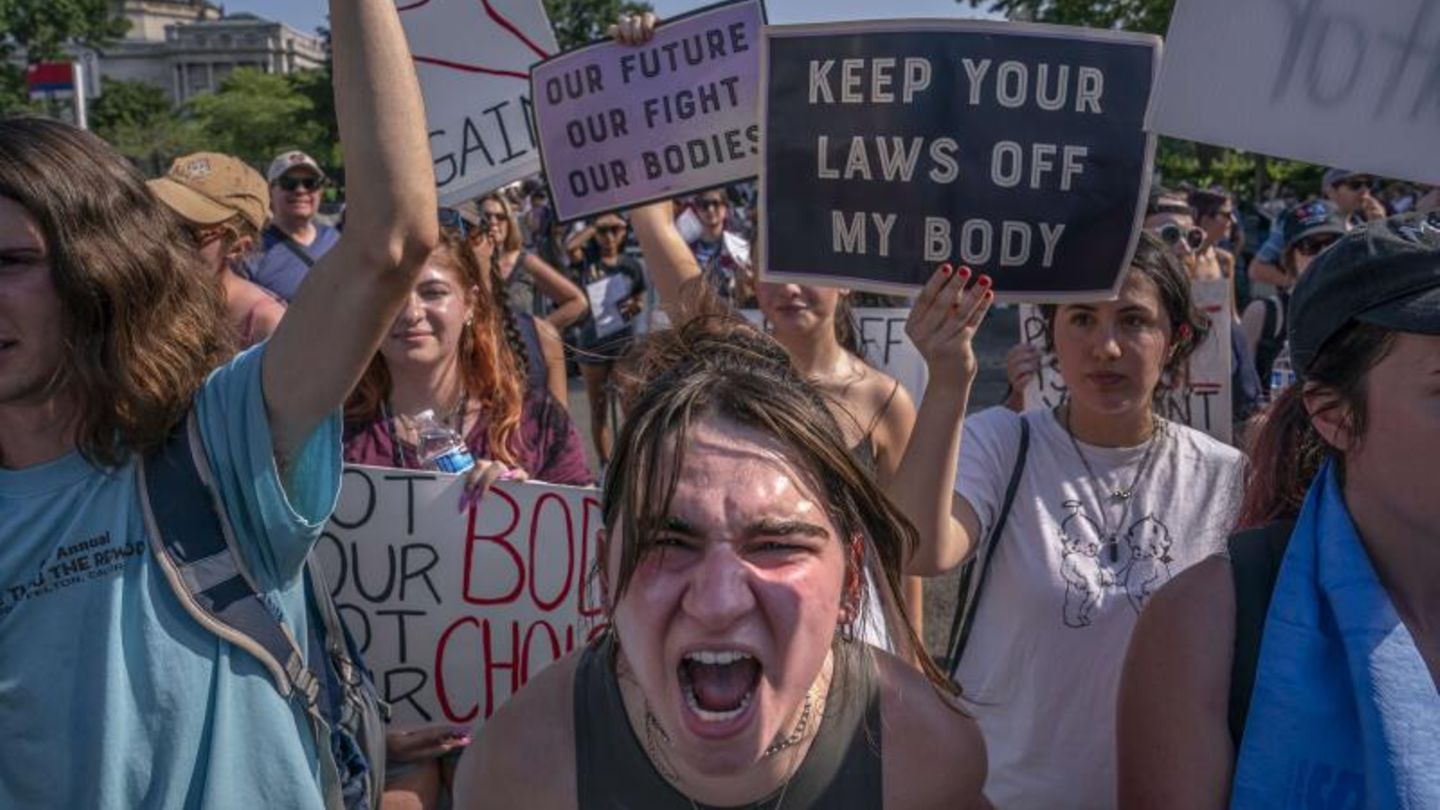It’s been seven days since the Supreme Court overturned abortion rights in the United States. Since then, numerous clinics have had to close, vasectomies are booming and a wave of protests is rolling through the country. A look into a divided America.
There are two words that strike like lightning in the United States: “Roe overturned”. Two words that have the power to turn back the clock and turn the lives of millions of people upside down. Two words that drive an already divided America even further apart.
Most Americans first hear of “Roe v. Wade” in high school. One of the most significant court decisions in American history, the 1973 Supreme Court decision secured the right to an abortion for almost 50 years. Now it is over. What has been announced for a long time will become reality on June 24th. The Supreme Court reversed its ruling at the time and dropped the abortion law – practically in the hands of the individual states. And they can’t act fast enough.
Within an hour of the verdict, Missouri announces that abortion is now banned. Louisiana, Kentucky and South Dakota follow. Alabama made abortion a criminal offense before noon. It lasts until 4 p.m. in Arkansas and 9 p.m. in Utah. At the end of the day, all abortion clinics in Texas closed. In Oklahoma, the last clinic has been closed since May. In Wisconsin, an 1849 law forces them to close—against the wishes of the Democratic governor. Five other states have already passed anti-abortion laws that will take effect automatically in a few weeks. The focus is now on nine other states – including Florida, Indiana and Montana. that they will extend the banned list.
Abortion verdict could affect half of women in the US
As recently as early June, almost every woman in the United States lived within a few hours’ drive of an abortion clinic. Now, a quarter of American women of childbearing age would have to travel more than 200 miles (over 300 kilometers) to have a legal abortion. Depending on how many states tighten their abortion laws, the number of people affected could rise to almost half, as one shows.
Caitlin Myers, an economist at Middlebury College in Vermont, has been analyzing access to abortion in America for three years. makes it clear that in a post-Roe reality, the decision of each individual state goes beyond the borders. Because the longer the distance to the nearest clinic, the fewer women make the trip in the first place. Thus, a woman’s chances of having a legal abortion depend not only on the law in her state, but also on what is happening in surrounding states. There is also no question that an above-average number of black and Latino women with lower incomes are affected.
But even those living in liberal states where abortion rights are protected could feel the impact of the Supreme Court ruling. In Colorado, Kansas and Illinois in particular – which will be surrounded by states with bans on abortion – clinics could be overwhelmed with patients from other states. “We’re going to see a tremendous number of women flocking to these states,” Professor Myers predicted. Concern is growing in many of these clinics as to how such an onslaught can be managed. “I think we’re going to end up with waiting lists and more patients than we can accommodate in the next few months,” said Dr. Erin King, executive director of the Hope Clinic for Women in Granite City, Illinois told the US newspaper.
Post-Roe boom of abortion pills and vasectomies
While one clinic after the other closed down in the hours after the verdict was announced, “Just the Pill” received almost 100 appointment requests; an NGO that distributes abortion pills in several states. Four times the usual number for the organization. Many came from patients in Texas and other states who stopped abortions shortly after court rulings.
The , which is also endorsed by other organizations, shows that medical abortion, which already accounts for half of all abortions in the US, will become even more popular in the post-Roe era. Closing clinics is one thing. According to legal experts, it is much more difficult to police the sending or receiving of pills by post. It should therefore only be a matter of time before abortion pills become the focus of various court proceedings.
At the same time, pharmacies and drugstores are also reporting a rush for the so-called morning-after pill. This can prevent unwanted pregnancy up to 72 hours after unprotected sex. As a result of the rush, the pharmacy chain CVS limited the amount sold to three packs per person, and the supermarket chain Walmart also restricted the sale of the morning-after pill.
But it’s not just women and other women who give birth who want to take precautions – men are also increasingly taking the consequences. According to media reports, the demand for vasectomies, a form of sterilization for men, has increased enormously in the past few days. A Cleveland hospital reported “that they typically receive three to four vasectomy requests a day.” But from Friday to Wednesday alone there were 90. A urologist from Miami told the broadcaster that he was now considering working on Saturdays because the phone rang so often. A doctor from Kansas City reports something similar: “Since Friday, the number of people who want to undergo a vasectomy has increased by 900 percent.”
The fight has begun – things will get serious in the fall
In its reasoning, the Supreme Court argued that the decision to overturn Roe was urgent because of the polarizing debate on abortion that has been going on for half a century. But since the verdict became public, a storm of protests has erupted across the states that eclipses everything that has gone before. While the demonstrations have so far remained mostly peaceful, tears of joy, angry “We won’t go back” chants and heated arguments show what is at stake for many.
Roe’s demise has sparked a massive mobilization on both sides of the abortion battle that many in politics can only dream of. As anti-abortion advocates find their case bolstered by the Supreme Court and are now pushing for near-total bans in every state, pro-lifers are decrying the ruling on the streets and in the courts and calling on the Biden administration to act .
And it wasn’t long in coming. To protect a nationwide right to abortion by law, Joe Biden wants to bypass the rules of Parliament for the first time. On the sidelines of the NATO summit in Madrid, Biden spoke out in favor of one on Thursday. The controversial Senate rule requires a “supermajority” of 60 of the 100 senators to even vote. But even to change the filibuster rule, the US President would need all Senate Democrats on board, which is far from the case with conservatives like Joe Manchin in his own ranks.
Many advocates of abortion rights are therefore turning their attention to the upcoming midterm elections in autumn. “Remember to vote in November” (“Don’t forget to vote in November”) – such a sign can now be found at almost every demonstration from Washington to Houston.
However, for many women who want an abortion, it may already be too late. Too late because of two words.
Sources: “”, “”, “”, “”, “”, with AFP material
Source: Stern
David William is a talented author who has made a name for himself in the world of writing. He is a professional author who writes on a wide range of topics, from general interest to opinion news. David is currently working as a writer at 24 hours worlds where he brings his unique perspective and in-depth research to his articles, making them both informative and engaging.



